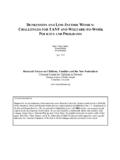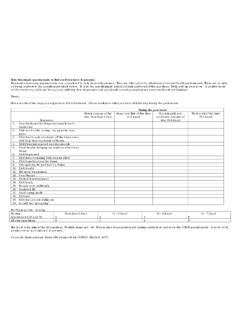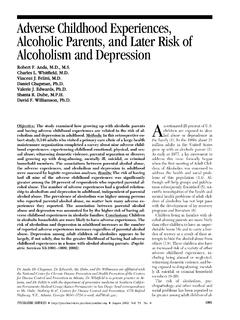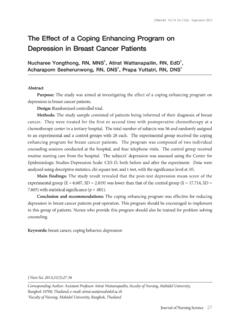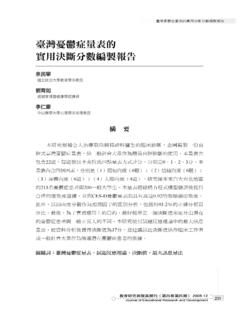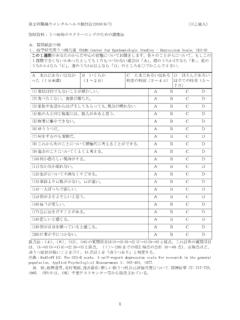Transcription of Asian Nursing Research - kan.or.kr
1 Research ArticleStructural Equation Model of Smartphone Addiction Based on AdultAttachment Theory: Mediating Effects of Loneliness and DepressionEunYoung Kim, PhD,1 Inhyo Cho, PhD,2 Eun Joo Kim, PhD3,*1 Department of Psychotherapy, College of Public Health and Safety, Kyungil University, Kyungsan, South Korea2 Department of Christian Counseling, Torch Trinity Graduate, University, Seoul, South Korea3 Department of Nursing , College of Health and Medical Science, Daejeon University, Daejeon, South Koreaarticle infoArticle history:Received 28 October 2016 Received in revised form25 April 2017 Accepted 2 May 2017 Keywords:smartphonefamily relationslonelinessdepressionhabitssumma ryPurpose:This study investigated the mediating effects of loneliness and depression on the relationshipbetween adult attachment and smartphone addiction in university :A total of 200 university students participated in this study.
2 The data was analysed usingdescriptive statistics, correlation analysis, and structural equation :There were significant positive relationships between attachment anxiety, loneliness, depres-sion, and smartphone addiction. However, attachment anxiety was not significantly correlated withsmartphone addiction. The results also showed that loneliness did not directly mediate betweenattachment anxiety and smartphone addiction. In addition, loneliness and depression serially mediatedbetween attachment anxiety and smartphone :The results suggest there are mediating effects of loneliness and depression in the rela-tionship between attachment anxiety and smartphone addiction.
3 The hypothesized model was found tobe a suitable model for predicting smartphone addiction among university students. Future study isrequired tofind a causal path to prevent smartphone addiction among university students. 2017 Korean Society of Nursing Science, Published by Elsevier Korea LLC. This is an open access articleunder the CC BY-NC-ND license ( ).IntroductionThe Korea Internet and Security Agency reported in 2014 thatsmartphone usage amongst Korean university students in theirtwenties was , with a dailyaverage of minutes, which wasthehighestrate ofanyagegroup[1]. Comparedto Korean high schoolstudentsorofficeworkers,itiseasier forKoreanuniversitystudentstoaccess their smartphones because they have more free time and areless under the authority of parents and teachers.
4 In addition, usingsmartphones might relieve their anxiety about the unpredictablefuture and stress from interpersonal conflicts, such as romanticrelationship breakups[2]. Due to excessive use, therefore, the highsmartphone usage rate among university students is apt to lead tothe InternetAddiction Surveyof2014 from the Ministry of Science, Information and CommunicationTechnology (ICT), and Future Planning, of university studentsareatriskofsmartphoneaddiction, , risk[3].Inotherwords,aboutoneinfiveunive rsitystudentsare at risk of smartphone addiction, which is a serious issue that theinternetalsohavea highprobabilityforaddiction,theportabili ty of smartphones might put them at greater risk ofbecoming addictive than either basic mobile phones or the researchers who have examined the relationship betweenattachment styles and internet or smartphone addiction report thatKorean youth or university students who have an insecureattachment style are more likely to become addicted to the internetor smartphone than those with a secure attachment style[4,5].
5 These young people are apt to use smartphones in order to meettheir need for attachment, thus regarding their smartphones asobjects of attachment. Other studies have determined thatdepressed Korean university students have a high tendency to beaddicted to smartphones[2]. For Korean university students, depression was found to be the highest predicting factor amongother risk factors for addiction, presenting a significantly positivecorrelation with smartphone addiction[6].Yet other studies have found that loneliness plays the role ofmediator to any addiction[7,8]. In a study by Park[7], smartphoneaddiction and loneliness presented a significantly positive*Correspondence to: Eun Joo Kim, PhD, Department of Nursing , College of Healthand Medical Science, Daejeon University, 2 Daehakro, Dongku, Daejoen 34519,South lists available atScienceDirectAsian Nursing Researchjournal e2093-7482/ 2017 Korean Society of Nursing Science, Published by Elsevier Korea LLC.
6 This is an open access article under the CC BY-NC-ND license ( ). Asian Nursing Research 11 (2017) 92e97correlation. The study also reported, through multiple regressionanalysis, that loneliness was a major predictive factor for socialnetworking service addiction[7]. Furthermore, loneliness has beenfound to be a mediating factor between attachment style andsmartphone or internet addiction[8].Flores[9], in exploring the relationship between insecure attach-ment style and addiction, suggested that addiction resulted fromattachment problems. According to the attachment theory of Bowlby[10], attachment is established between an infant and the infant'sprimary caregiver through emotional bonds facilitated by physicalcontact and familiarity.
7 Insecurely attached persons have a negativeimage of self or others in their internal working models due to result,insecurelyattached people mighteitherbecome dependent on or avoidant of others[11]. Brennan et al[12]define attachment anxiety as having a fear of rejection and attachment avoidance as a fear of closeness and dependency[13].According to Flores, the reason why substance abusers becomeaddicts is because they experience difficulties with emotionalregulation[9]. Addiction is regarded as an alternative to overcomingthe difficulties in their relationships, which worsens their attach-ment capabilities. Those who have insecure attachment styles arelikely to become addicted due to their deficiency in regulating theiremotions effectively[9].
8 In a similar vein, Catanzaro and Mearns[14]insist that people who are able to cope with or regulate theirnegative emotions well are less prone to becoming Korea, it has been shown that differences in attachment styleshave a high correlation with depression or the lack of depression [15,16]. In particular, Kim and Oh[15]found that those who hadanxious and avoidant attachment styles were more likely to sufferfrom depression . Wei et al[13]found that both anxious and avoi-dant attachment styles had strong associations with increasedloneliness and difficulties in interpersonal relationships. Yetanother study[16]discovered that an anxious attachment style haddirect and indirect effects on loneliness and depression .
9 Based onthese previous studies, this study explored the mediating effects ofdepression and loneliness in the relationship between smartphoneaddiction and attachment study sought to build a conceptual framework based on apremise rooted in Flores' theory and attachment theory[9,10]:insecurely attached university students tend to feel loneliness anddepression, and cannot regulate their emotions properly. Theytherefore choose smartphones as self-objects to reduce their applying Flores' assertion in conjunction with thefindings ofprevious studies[9], the present study aimed to suggest the pathsbetween the risk factors and the mediating effects of depressionand loneliness in the relationship between smartphone addictionand attachment purpose of this study was to propose a structural equationmodel between attachment style and smartphone addiction basedon Flores' argument that people become addicted because theyexperience difficulties with emotional regulation[9].
10 To do this, weverified the hypothesized structural equation model and examinedthe mediating effect of loneliness and depression in the relation-ship between attachment style and smartphone designA cross-sectional Research design was employed to explore thecausal pathways linking attachment to smartphone addiction inuniversity sampleThe participants for this Research were university studentsenrolled in a major or elective class at one of the four universitieslocated in cities designated as A, C, S, and P. The age range was20e30 years old. The reason for choosing this age limit was that therate of smartphone usage in the twenties was the highest and twotimes longer than any other working adult group[3].



